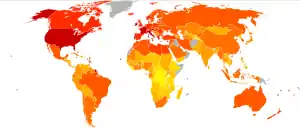Dietary energy supply
The dietary energy supply is the food available for human consumption, usually expressed in kilocalories or kilojoules per person per day. It gives an overestimate of the total amount of food consumed as it reflects both food consumed and food wasted.[1] It varies markedly between different regions and countries of the world. It has also changed significantly over the 21st century. Dietary energy supply is correlated with the rate of obesity.[2]

Map of dietary energy availability per person per day in 2001-2003.

Map of dietary energy availability per person per day in 1989-1991.

Map of dietary energy availability per person per day in 1979-1981.
Energy values in kilocalories (kilojoules)
no data
<1600 (<6,700)
1600-1800 (6,700–7,500)
1800-2000 (7,500–8,400)
2000-2200 (8,400–9,200)
2200-2400 (9,200–10,000)
2400-2600 (10,000–10,900)
2600-2800 (10,900–11,700)
2800-3000 (11,700–12,600)
3000-3200 (12,600–13,400)
3200-3400 (13,400–14,200)
3400-3600 (14,200–15,100)
>3600 (>15,100)
Regions
Daily dietary energy supply per capita:
| Region | 1964-1966 | 1974-1976 | 1984-1986 | 1997-1999 |
|---|---|---|---|---|
| World[3] | 2,358 kcal (9,870 kJ) | 2,435 kcal (10,190 kJ) | 2,655 kcal (11,110 kJ) | 2,803 kcal (11,730 kJ) |
| Sub-Saharan Africa[3] | 2,058 kcal (8,610 kJ) | 2,079 kcal (8,700 kJ) | 2,057 kcal (8,610 kJ) | 2,195 kcal (9,180 kJ) |
Countries
| Country | 1979-1981 | 1989-1991 | 2001-2003 |
|---|---|---|---|
| Canada[4] | 2,930 kcal (12,300 kJ) | 3,030 kcal (12,700 kJ) | 3,590 kcal (15,000 kJ) |
| China[5] | 2,330 kcal (9,700 kJ) | 2,680 kcal (11,200 kJ) | 2,940 kcal (12,300 kJ) |
| Swaziland[6] | 2,400 kcal (10,000 kJ) | 2,450 kcal (10,300 kJ) | 2,360 kcal (9,900 kJ) |
| United Kingdom[7] | 3,170 kcal (13,300 kJ) | 3,250 kcal (13,600 kJ) | 3,440 kcal (14,400 kJ) |
| United States[8] | 3,180 kcal (13,300 kJ) | 3,460 kcal (14,500 kJ) | 3,770 kcal (15,800 kJ) |
References
- "Compendium of food and agriculture indicators - 2006". FAO. Archived from the original on August 2, 2008. Retrieved February 18, 2009.
- Moussavi N, Gavino V, Receveur O (November 2008). "Is obesity related to the type of dietary fatty acids? An ecological study". Public Health Nutr. 11 (11): 1149–55. doi:10.1017/S1368980007001541. PMID 18194589.
- "Global and regional food consumption patterns and trends". FAO.
- "www.fao.org" (PDF).
- "www.fao.org" (PDF). Archived from the original (PDF) on 2009-01-14.
- "www.fao.org" (PDF).
- "www.fao.org" (PDF).
- "www.fao.org" (PDF).
- "World Food and Agriculture – Statistical Yearbook 2021". www.fao.org. doi:10.4060/cb4477en. Archived from the original on 2021-11-03. Retrieved 2021-12-10.
External links
- Food and Agriculture Organization of the United Nations (1996). The Sixth World Food Survey 1996. Food & Agriculture Org. ISBN 92-5-103837-6.
This article is issued from Wikipedia. The text is licensed under Creative Commons - Attribution - Sharealike. Additional terms may apply for the media files.
